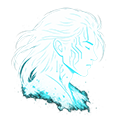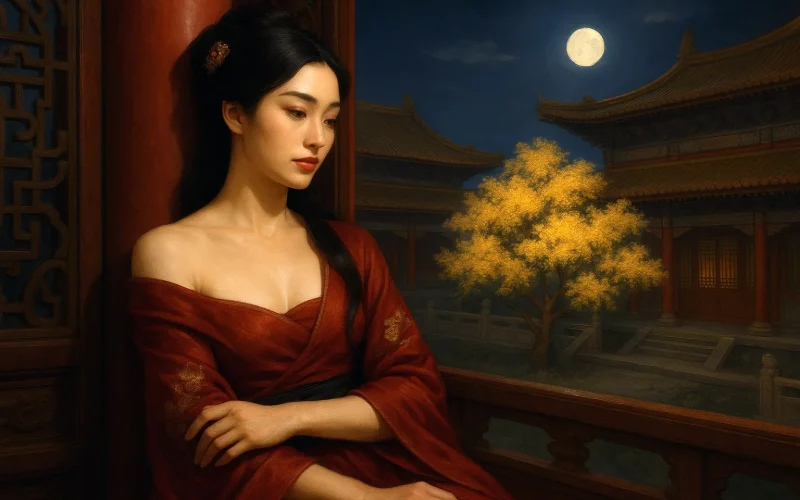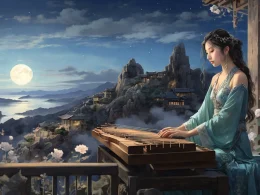The autumn wind is clear,
The autumn moon is bright.
Fallen leaves gather but then scatter,
The crow roosts but again is startled.
We long for each other but when can we meet?
It’s hard for me to bear such a lonely night!
If I had known that it’d grip my heart so,
I’d have rather not met you long ago.
Original Poem
「三五七言 · 秋风词」
李白
秋风清,秋月明,
落叶聚还散,寒鸦栖复惊。
相思相见知何日?此时此夜难为情!
入我相思门,知我相思苦,
长相思兮长相忆,短相思兮无穷极,
早知如此绊人心,何如当初莫相识。
Interpretation
This work exemplifies Li Bai's masterful command of the 3-5-7-character poetic form. While not its inventor, Li Bai elevated this structure to paradigmatic status through universal emotional resonance and artistic refinement. Set against an autumn night's temporal backdrop, the poem seamlessly synchronizes subtle natural movements with profound human emotions, tracing a complete psychological journey from scene-inspired sentiment to direct expression, culminating in philosophical contemplation.
First Couplet: "秋风清,秋月明,落叶聚还散,寒鸦栖复惊。"
Qiūfēng qīng, qiūyuè míng, luòyè jù hái sàn, hányā qī fù jīng.
Autumn winds clear, autumn moon bright; Leaves gather then scatter, jackdaws roost then startle.
The opening uses two sets of crisp 3-character lines like quick scene shifts, establishing a clear, cold tone. The following 5-character lines are pivotal: capturing nature's instantaneous changes - "gather/scatter" and "roost/startle." These are not merely physical phenomena but precise metaphors for human separations/reunions and emotional fluctuations, providing a solid philosophical and aesthetic foundation for the ensuing "longing."
Second Couplet: "相思相见知何日?此时此夜难为情!"
Xiāngsī xiāngjiàn zhī hé rì? Cǐshí cǐ yè nánwéiqíng!
Longing to meet—but know not when; This hour, this night—emotion overwhelms!
The poem shifts directly from scene to emotion with a question full of boundless regret, pouring out pent-up feelings. "This hour, this night" freezes time, contrasting with the previous vast space, focusing emotion on present unbearable anguish. "Emotion overwhelms" perfectly captures those tangled, helpless complex feelings.
Third Couplet: "入我相思门,知我相思苦。"
Rù wǒ xiāngsī mén, zhī wǒ xiāngsī kǔ.
Enter my longing's gate, Know my longing's pain.
Unique brushwork here hypothesizes a dialogic object, elevating personal experience to a universal "longing" realm. "Longing's gate" symbolizes an emotional space where entering means confronting essential bitterness. This deepens the emotion while transitioning from personal experience to universal understanding.
Fourth Couplet: "长相思兮长相忆,短相思兮无穷极。"
Cháng xiāngsī xī cháng xiàngyì, duǎn xiāngsī xī wúqióng jí.
Endless longing brings endless memory; Brief longing feels infinitely prolonged.
Using anadiplosis and repetition creates cyclical rhythm mirroring longing's endlessness. The "long/short" dialectic reveals longing's essence: unaffected by objective duration, once born, it consumes all sense of time, becoming a perpetual state.
Fifth Couplet: "早知如此绊人心,何如当初莫相识。"
Zǎo zhī rúcǐ bàn rénxīn, hérú dāngchū mò xiāngshí.
Had I known how it shackles the heart, Better never to have met at all!
This is the poem's emotional vortex—extreme regret expressing extreme devotion. Not rational resolve but pain-induced extremity. "Shackles" vividly depicts longing chaining the heart. This hypothetical reversal of cause and effect pushes emotional conflict to its peak with tragic power.
Holistic Appreciation
The poem's charm lies in extreme emotional sincerity and formal harmony. Like an emotional sonata: the first couplet presents natural/emotional motifs; the second develops initial agitation; the third/fourth vary and deepen the theme; the fifth recaps and concludes with resonant conflict. Through irregular line lengths, the poet mimics heart-tide fluctuations, expanding a momentary autumn night reflection into profound exploration of love's essence.
Artistic Merits
- Perfect Isomorphism of Form and Emotion: Alternating 3-5-7-character lines shift rhythm from urgent to expansive to resigned, perfectly matching the emotional flow from scene-trigger to feeling to reflection.
- Metaphorical Imagery: "Leaves gather then scatter" transforms into symbol of human encounters; "jackdaws roost then startle" externalizes anxious inner states. Scenery becomes emotional language.
- Paradoxical Emotional Expression: Using "regret" (better not to meet) to express "love," using resolve to convey inextricability—this paradox greatly enhances emotional tension and depth.
- Flexible Perspective Shift: From soliloquy (describing scenes) to exclamation (emotion overwhelms), then to virtual dialogue (know my pain), finally returning to internal resolution—the shifting perspective thoroughly reveals complex inner activity.
Insights
This poem touches upon a fundamental paradox of human emotion: the most profound beauty often coexists with the most intense pain. Li Bai's expression of "regret" does not reject love itself, but rather acknowledges its uncontrollable power to reshape one's life. It reveals that authentic living requires the courage to embrace things that "bind the heart." While avoiding connection may spare us pain, it also causes us to miss the deepest joys and sorrows that define our humanity. The poem's value lies in its honest confrontation with emotional truth—even while sighing "had I known," we still cherish that "first meeting" moment. Such complete acceptance of life's complexity represents profound wisdom and courage.
About the poet

Li Bai (李白), 701 - 762 A.D., whose ancestral home was in Gansu, was preceded by Li Guang, a general of the Han Dynasty. Tang poetry is one of the brightest constellations in the history of Chinese literature, and one of the brightest stars is Li Bai.












